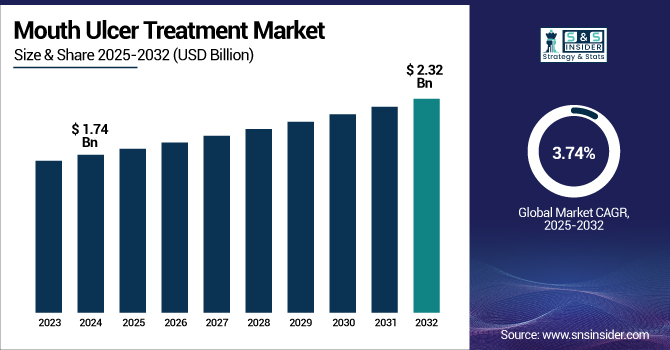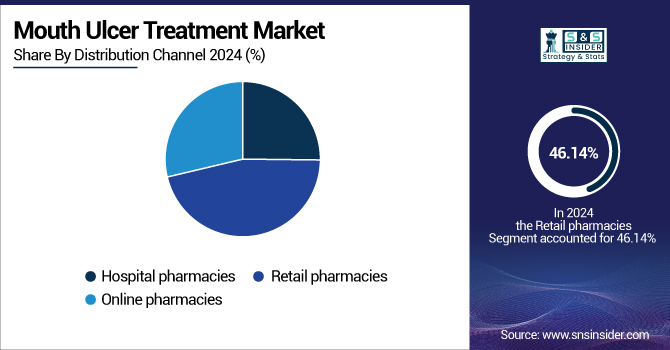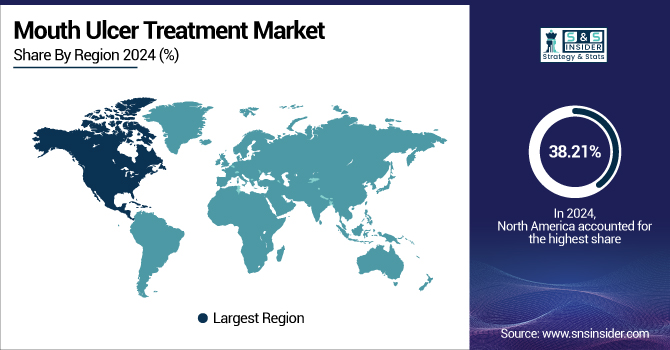Mouth Ulcer Treatment Market Size & Overview
The Mouth Ulcer Treatment Market size is projected to grow from USD 1.74 billion in 2024 to USD 2.32 billion by 2032, at a CAGR of 3.34% during the forecast period 2025-2032.

To Get more information on Mouth Ulcer Treatment Market - Request Free Sample Report
The mouth ulcer treatment market is growing steadily with the increasing incidence of oral ailments like aphthous stomatitis, oral lichen planus, and candidiasis. There is growing awareness of oral health, the increasing demand for over-the-counter drugs, and improved access to healthcare services in developing countries driving the market growth.
For Instance, according to WHO, though mainly preventable, oral diseases are a significant health burden in many nations, affecting people at all stages of life and leading to pain, discomfort, deformity, and even death. It is estimated that around 3.7 billion people suffer from oral illnesses. Product development through new drugs and the increasing population of older people are further driving the market demand.
The U.S. mouth ulcer treatment market size was valued at USD 0.57 billion in 2024 and is expected to reach USD 0.75 billion by 2032, growing at a CAGR of 3.50% over the forecast period of 2025-2032. The U.S. leads the North American mouth ulcer treatment market owing to high healthcare spending, extensive availability of over-the-counter oral care products, and high consumer awareness. Moreover, the presence of large pharmaceutical and oral care firms further consolidates its dominant position in the region.
Mouth Ulcer Treatment Market Dynamics
Drivers
-
Increasing Incidence of Oral Disorders is Propelling the Mouth Ulcer Treatment Market Trends
The high prevalence rate of oral conditions like aphthous stomatitis, oral candidiasis, and oral lichen planus is primarily fueling the mouth ulcer treatment market. These conditions are induced by stress, hormonal fluctuations, nutritional deficiencies (particularly vitamins B12, C, and folic acid), food allergies, and improper oral hygiene. The popularity of tobacco and alcohol and their high consumption rate are also stressing out the oral tissues to an extent that ulcers form at an increased rate. As more people suffer from such problems, the need for efficient and quick-acting treatments has increased tremendously, driving market growth.
For Instance, according to WHO, the incidence of significant oral illness is on the increase globally, propelled by growing urbanization and changing lifestyles. The major contributory factors include restricted exposure to fluoride, both within water sources and dental care items such as toothpaste, combined with ample access to and affordability of high-sugar diets. Compounding this, oral health care services are limited within many communities. Intensive marketing and increasing consumption of sweet foods, drinks, tobacco, and alcohol have also contributed to the burden of oral diseases and other non-communicable diseases (NCDs).
-
Increasing Geriatric Population is driving the Mouth Ulcer Treatment Market Growth
Elderly patients are particularly at risk for developing mouth ulcers as a consequence of changes with aging in body physiology, diminished immune status, and conditions such as diabetes mellitus or gastrointestinal disease. Other factors include the use of dentures and polypharmacy, leading to dry mouth or mucosal inflammation and raising ulcer risk. With the increasing global population of elderly people, especially in North America, Europe, and some areas of Asia, the demand for uniform and effective treatment of mouth ulcers has become more acute, increasing the demand in this market.
Restraint
-
Limited Awareness in Developing Regions is Restraining the Global Mouth Ulcer Treatment Market
Despite the existence of effective therapies, a large segment of the population in low- and middle-income countries is not aware of proper oral hygiene measures and existing therapeutic solutions for mouth ulcers. This unawareness results in underdiagnosis and untreated conditions, particularly in rural and underserved communities. Moreover, cultural stigmas and restricted access to dental or medical experts also discourage market growth. Most individuals turn to home remedies rather than seeking expert treatment, which lowers the demand for clinically approved products. Not only does this, lack of awareness also limit market penetration, but it also hinders the uptake of newer, better treatment options.
Mouth Ulcer Treatment Market Segmentation Analysis
By Drug Class
In 2024, the analgesics & corticosteroids segment dominated the mouth ulcer treatment market share with 36.15%, due to its high efficacy in decreasing pain and inflammation, which are key symptoms of mouth ulcers. These medications offer quick relief from symptoms and thus are the preferred choice among healthcare providers and patients alike. Easily available in various forms like gels and creams, they are usually prescribed for treating moderate to severe cases. Their established therapeutic role, combined with high physician credibility, drove their dominant market position in 2024.
The antimicrobial segment will experience the fastest growth in the forecasting period as increasing awareness of the role of infection, particularly bacterial and fungal, of provoking or exacerbating mouth ulcers, picks up pace. Increasing demand for targeted therapies that both relieve symptoms and treat the underlying microbial origins is driving this. Also, growing availability of antimicrobial mouthwashes and lozenges, along with a rise in prescriptions for combination therapies, lends support to the swift uptake of antimicrobial drugs in the forecast years.
By Drug Form
The gels segment dominated the mouth ulcer treatment market with 42.10% market share in 2024, with its better application advantages and extended mucosal stay. Gels guarantee targeted delivery, allowing active substances, such as corticosteroids or painkillers, to remain constantly in contact with the ulcered area for quite a long period, thus enhancing the therapeutic effect. This type also ensures quick relief from pain and discomfort, hence being most popular among patients and doctors alike. Its simplicity in application and being available over the counter also made it a leading product in the market.
The sprays segment is anticipated to exhibit the fastest growth during the forecast years as a result of heightened consumer demand for convenient and hygienic treatment solutions. Sprays provide quick and painless application without direct physical contact with the ulcer, ideally for children and those with extreme mouth pain. With continued technology growth in drug delivery systems and growing accessibility, sprays are also expected to see increased adoption, especially in home and self-care settings.
By Indication
The aphthous stomatitis segment dominated the aphthous ulcer treatment market in 2024 with 54.11% because of its increased global prevalence and impact on the need for frequent treatment.
For Instance, according to NCBI, approximately 25% of the global population suffers from RAS, making it one of the most common oral mucosal conditions worldwide.
Aphthous ulcers, also referred to as canker sores, are among the most frequent oral lesions diagnosed, particularly among young adults and adolescents. Onset is induced by stress, hormonal changes, nutritional deficiencies, as well as minor oral trauma. Because the ulcers recur frequently, patients require repeated treatment; therefore, a need for various therapeutic products, especially the topical ones such as gels and mouthwashes.
The oral candidiasis segment is projected to record the fastest growth during the forecast period, driven by rising incidences of immunosuppressive conditions, the higher usage of antibiotics, and the growing base of elderly individuals and denture users. Oral candidiasis with candida species overgrowth is commonly seen among diabetics, cancer patients, and steroid patients. Increased sensitivity and diagnosis rates for fungal infection and improved antifungal therapeutics are predicted to drive this oral ulcer treatment market segment ahead.
By Distribution Channel
The retail pharmacies segment dominated the mouth ulcer treatment market with 46.14% market share in 2024 because of extensive availability, instant product availability, and consumer preference for direct consultations with pharmacists. These pharmacies are well established in urban and rural areas so that patients can easily procure over-the-counter medications like gels, mouthwashes, and lozenges without a prescription. Also, the established familiarity and confidence over the years with local pharmacists contribute significantly to sustained consumer dependence on retail stores for treating common oral conditions.
The online pharmacies segment is expected to witness the fastest growth during the forecast years, driven by the rising adoption of digital, convenience, and the expanding infrastructure of e-commerce. Consumers prefer purchasing healthcare products from online stores increasingly due to home delivery, price comparison, and visibility to a broader range of brands and formulations.

Mouth Ulcer Treatment Market Regional Outlook
North America dominated the mouth ulcer treatment market with a market share of 38.21% in 2024, mainly due to the fact that it has well-established healthcare facilities, a high degree of oral health awareness, and a high incidence of lifestyle risk factors such as stress and lack of nutrition. The region is also favorable with good distribution channels, high availability of over-the-counter drugs, and a well-established pharmaceutical industry. Apart from that, greater healthcare expenditure and availability of major market participants drive early diagnosis and timely management of mouth ulcers, supporting the leadership of the region's market.
Asia Pacific is the fastest-growing region in the mouth ulcer treatment market with 4.65% CAGR over the forecast period due to its huge and aging population, high incidence of oral diseases, and increasing access to healthcare in emerging nations. Increased consumer awareness, urbanization, and changing dietary habits are driving demand for mouth ulcer treatment products. Further, government initiatives to boost healthcare infrastructure and the strong expansion of retail and e-commerce pharmacy channels are driving the growth of the market in the region.
Germany has a leadership role in the European mouth ulcer treatment market because of its strong healthcare infrastructure, high awareness of oral health, and well-established presence of pharmaceutical and consumer health firms. The nation is also favored with a high prevalence of OTC drug use and availability of advanced treatments. Also, Germany's focus on preventive oral care and regular dental visits helps in the early detection and treatment of mouth ulcers, helping it play a leading role in the region.
Latin America and the Middle East & Africa (MEA) exhibit moderate growth in the mouth ulcer treatment market as a result of enhanced accessibility to healthcare and growing awareness about oral hygiene. While economic limitations and reduced healthcare expenditure could restrict rapid growth, urbanization and demand for OTC products are increasingly driving market activity.

Get Customized Report as per Your Business Requirement - Enquiry Now
Key Players in the Mouth Ulcer Treatment Market
GlaxoSmithKline, Pfizer, Colgate-Palmolive, 3M, Bristol Myers Squibb, Sun Pharmaceutical, Bausch Health, Church & Dwight, BLISTEX, ECR Pharmaceuticals, and other players.
Recent Developments
-
In March 2024, Bausch Health Companies Inc. and its gastroenterology unit, Salix Pharmaceuticals, publicly endorsed a Phase 2 investigator-initiated study (IIS) that is assessing RELISTOR (methylnaltrexone bromide; MNTX) in patients with resectable head and neck squamous cell carcinoma. The IIS is independently conceived and operated by an external qualified sponsor who bears complete study responsibility.
-
In October 2023, Pfizer Inc. reported that the U.S. Food and Drug Administration (FDA) has approved VELSIPITY (etrasimod), an oral once-daily selective sphingosine-1-phosphate (S1P) receptor modulator. The medication is approved for the treatment of moderately to severely active adult ulcerative colitis (UC), with a dose of 2 mg recommended.
| Report Attributes | Details |
|---|---|
| Market Size in 2024 | USD 1.74 Billion |
| Market Size by 2032 | USD 2.32 Billion |
| CAGR | CAGR of 3.74% From 2025 to 2032 |
| Base Year | 2024 |
| Forecast Period | 2025-2032 |
| Historical Data | 2021-2023 |
| Report Scope & Coverage | Market Size, Segments Analysis, Competitive Landscape, Regional Analysis, DROC & SWOT Analysis, Forecast Outlook |
| Key Segments | • By Drug Class (Antimicrobial, Antihistamine, Analgesics & Corticosteroids, Other Drug Classes) • By Drug Form (Sprays, Mouthwash, Gels, Lozenges) • By Indication (Aphthous Stomatitis, Oral Lichen Planus, Oral Candidiasis, Other Indications) • By Distribution Channel (Hospital Pharmacies, Retail Pharmacies, Online Pharmacies) |
| Regional Analysis/Coverage | North America (US, Canada, Mexico), Europe (Germany, France, UK, Italy, Spain, Poland, Turkey, Rest of Europe), Asia Pacific (China, India, Japan, South Korea, Singapore, Australia, Rest of Asia Pacific), Middle East & Africa (UAE, Saudi Arabia, Qatar, South Africa, Rest of Middle East & Africa), Latin America (Brazil, Argentina, Rest of Latin America) |
| Company Profiles | Thermo Fisher Scientific, Agilent GlaxoSmithKline, Pfizer, Colgate-Palmolive, 3M, Bristol Myers Squibb, Sun Pharmaceutical, Bausch Health, Church & Dwight, BLISTEX, ECR Pharmaceuticals, and other players. |

